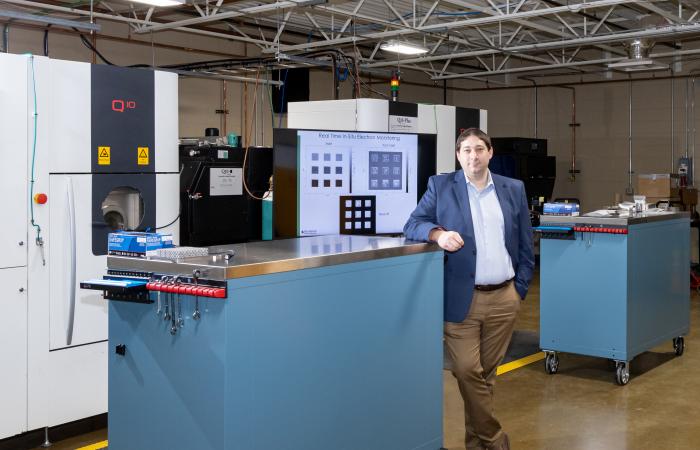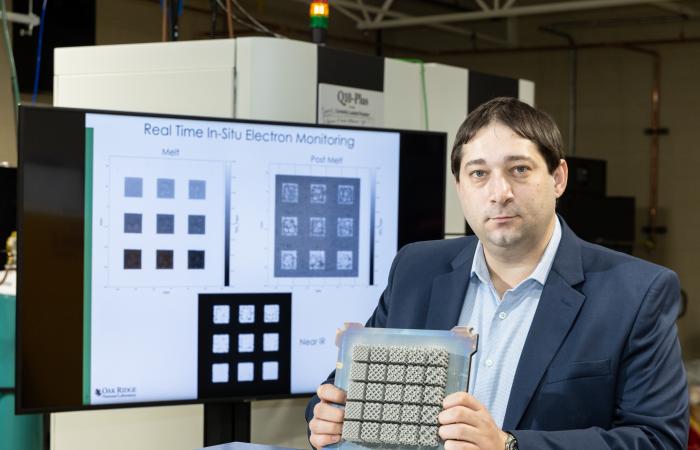-

Mike Kirka, ORNL materials scientist, led a team that produced an additively manufactured and machined blade for a high-temperature, land-based industrial gas turbine engine, which was successfully demonstrated, withstanding extreme temperatures at full capacity. Credit: ORNL/U.S. Dept. of Energy
-

In situ monitoring to evaluate nickel-based superalloys as they are printing gave Mike Kirka, an ORNL materials scientist, the ability to see potential weaknesses that could lead to part failure. Credit: ORNL/U.S. Dept. of Energy
-

Mike Kirka, ORNL materials scientist, led a team that produced an additively manufactured and machined blade for a high-temperature, land-based industrial gas turbine engine, which was successfully demonstrated, withstanding extreme temperatures at full capacity. Credit: ORNL/U.S. Dept. of Energy
-

In situ monitoring to evaluate nickel-based superalloys as they are printing gave Mike Kirka, an ORNL materials scientist, the ability to see potential weaknesses that could lead to part failure. Credit: ORNL/U.S. Dept. of Energy
Growing up in the heart of the American automobile industry near Detroit, Oak Ridge National Laboratory materials scientist Mike Kirka was no stranger to manufacturing. His parents worked in the auto industry, and Kirka himself spent time with General Motors in the assembly plants as an intern while completing undergraduate work in engineering.
"I was around traditional manufacturing, the industrial side of things, processing and assembling," he said. "In the early days of that research, it was more polymer based and focused on how additive could be applied to the medical field. Later on, I saw the switch to additive manufacturing."
Kirka's exposure to an assembly plant environment and the start-to-finish production process led him to take a keen interest in materials - their development and how their attributes can impact the performance of an automobile over time.
"I started to think about how important it was for a material to maintain its integrity in extreme environments," he said. "High-temperature materials were a key consideration for production."
With additive manufacturing gaining traction, Kirka also began to see that material science would play a pivotal role in helping it become more mainstream.
"How do you put a material in not just an automobile, but a rocket, for example, and not have it fall apart when encountering extreme heat?" he asked. "The applications that additive manufacturing could be used for were endless, but it largely hinged on the materials used as to its viability long term."
The turbine test
After finishing his PhD in mechanical engineering at the Georgia Institute of Technology, Kirka had his sights set on doing consulting work for industry after graduation. However, a professor at his alma mater who had recently visited ORNL encouraged Kirka to instead consider working for a national laboratory.
"My professor had toured ORNL and saw all the research that was being done in additive, including the 3D printing of the underwater robotic arms," Kirka said. "He came back and said this is where I needed to be to best apply my expertise and interests."
Kirka followed the career advice and joined the lab in 2014. Over the past five years, he's had the opportunity to put materials to the extreme heat test while working as a researcher based at the Department of Energy's Manufacturing Demonstration Facility at ORNL. As a postdoctoral research fellow, Kirka worked with the materials science division to develop a crack free nickel-based superalloy for additive manufacturing. Since then, he's quickly moved up the ranks, transitioning to an associate research post, a full staff researcher and now a group leader for deposition science and technology in the lab's manufacturing science division. All the while Kirka has remained focused on nickel-based superalloys.
"I've done a lot of work on these superalloys because they're rare in that they can go up to about 1,100 degrees Celsius," he said. "They have the reach capacity that's hard to find (in other materials)."
Kirka formed a research team at ORNL to develop a process that enables the development of materials with ever-increasing operational capabilities, working with polycrystalline, columnar and single textures and using additive manufacturing to demonstrate the increased material performance.
Recently, this team successfully fabricated, certified and qualified the first set of additively manufactured and machined blades for a land-based industrial gas turbine engine and later collaborated with industry to demonstrate their performance in a commercial engine. Made of a high gamma prime nickel-based superalloy, the blades withstood the extreme environment found in a heat-fired industrial gas turbine engine and produced power at full engine output.
In situ monitoring to evaluate the blades as they're printed gave researchers the ability to see potential weaknesses in the material, which could lead to part failure. By capturing all of the data during the 3D printing of several blades, a digital twin was created that serves as a guide for future prints.
"Normally when materials like steel are used for engines like this, a failure is catastrophic to the whole system," Kirka said. "If the blade disintegrates, for example, it goes through the whole engine at that point and ultimately the whole boiler explodes. And, if there's a crack in the steel, a leak can occur, and the pressure inside can cause an explosion. Any mistake in manufacturing is costly."
Being able to predict the performance of how well a component will perform in equipment significantly reduces risks for manufacturers.
"This is where adopting additive for these components can decrease the risk of errors," Kirka said. "Manufacturers have been used to the traditional way, and they're naturally afraid of taking on risk with other processes. But with additive, we can bring the cost down and the risk."
"I wouldn't say we're 100% yet with the data we've gathered and the digital twin we've produced for the blades but we're very close," he added. "We know the parameters for producing a 3D-printed part for this type of engine now."
Kirka said the demonstration ultimately proved that additive manufacturing can be used successfully for the production of turbine blades made of superalloys and provides superior performance as compared to traditional casting and tooling manufacturing processes. This reduces the time it takes to manufacture, decreases costs and enables these blades to be put into service much more quickly and efficiently.
No limits
Beyond developing high-temperature superalloys for turbines, Kirka is investigating how these alloys will perform inside a nuclear reactor and even in outer space.
"We've sent samples of materials to be tested in space," he said. "All materials have their limits, but we have thus far achieved what seemed impossible. Testing it in outer space is just the next level."
Kirka also sees that additive manufacturing can further play a pivotal role in the automobile industry.
"I think automotive is a more unique case on figuring out how to use additive on a large scale," he said. "They're very particular because you're making millions of the same part per year. We have to know how to scale additive manufacturing up to those levels and make advances in tooling that will allow for the mass production of parts."
ORNL researchers demonstrated the feasibility of 3D printing an automobile with the large-scale additive manufacturing of the Strati in 2014, the Shelby Cobra in 2015 and other vehicles since then.
"We have to figure out the problem of producing parts on a large scale, how to make it affordable enough to make a lot of them so that the vehicles are then affordable for the consumer," Kirka added. "They're using additive more in the automobile plants and in how cars are assembled, but really actually making a car out of additive on the commercial scale I think is going to take some more ingenuity."
At this early stage of his research career, Kirka is already being recognized for innovating. He has received the 2021 Young Innovator in the Materials Science of Additive Manufacturing Award from the Minerals, Metals and Materials Society.
"We're rebuilding and revitalizing manufacturing. Additive manufacturing will have a big impact on our society, and the U.S. is positioned to lead on the international stage," he said. "It's not your grandfather's manufacturing any longer."






